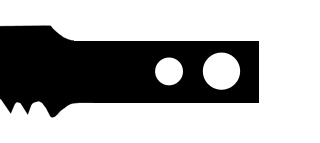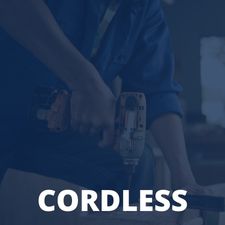
The Best Corded and Cordless Jigsaw in Australia — Information, Buyers Guides, Comparisons, and Reviews
Creating accurate, nonlinear cuts in wood, metal, and plastic is challenging — yet, a corded or cordless jigsaw can make these jobs effortless. Their thin blades and perpendicular cutting actions allow you to gently guide the tool through your target material — aided by illuminating lamps, detritus blowers, and dust extractors. And available in pro and DIY-grade models — and at a variety of price points — there’s a unit available for every budget and level of experience.
Table of Contents
- What Are Corded and Cordless Jigsaw Tools?
- Jigsaw Blade Types
- Jigsaw Blade Construction
- Blade Applications
- Jigsaw Blade Cutting Capacity
- Jigsaw Operating Tips
- How To Choose the Best Cordless Jigsaws and Corded Jigsaws
- Our Top Picks of the Ultimate Cordless and Corded Jigsaws
- Jigsaw Conclusion
- Jigsaws FAQs
| IMAGE | PRODUCT | DETAILS | ||
|---|---|---|---|---|
|
Best Battery Powered Jigsaw 
|
Best Battery Powered Jigsaw
|
Bosch PST 18 LI
|
Features
|
Check Price Now Bosch PST 18 LI Review Bosch PST 18 LI Review |
|
Best Budget Jigsaw 
|
Best Budget Jigsaw
|
Black+Decker BDCJS18N-XE
|
Features
|
Check Price Now Black+Decker BDCJS18N-XE Review Black+Decker BDCJS18N-XE Review |
|
Best 18v Jigsaw 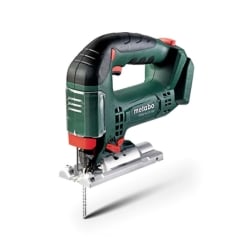
|
Best 18v Jigsaw
|
Metabo STAB 18 LTX 100
|
Features
|
Check Price at Tools Check Price at Toolmart Metabo STAB 18 LTX 100 Review Metabo STAB 18 LTX 100 Review |
|
Best Jigsaw for Stroke Rate 
|
Best Jigsaw for Stroke Rate
|
Milwaukee M18FJS-0
|
Features
|
Check Price at Tools Check Price at Toolmart Milwaukee M18FJS-0 Review Milwaukee M18FJS-0 Review |
|
Best Jigsaw for Novices 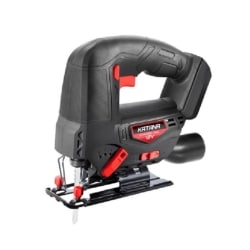
|
Best Jigsaw for Novices
|
Katana 220040
|
Features
|
Check Price at Tools Check Price at Toolmart Katana 220040 Review Katana 220040 Review |
|
Best Jigsaw for Awkward Angles 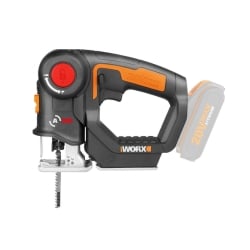
|
Best Jigsaw for Awkward Angles
|
WORX WX550.9
|
Features
|
Check Price Now WORX WX550.9 Review WORX WX550.9 Review |
|
Best Jigsaw for Brawn 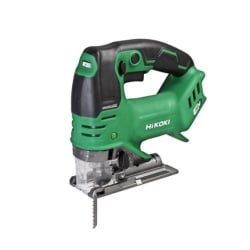
|
Best Jigsaw for Brawn
|
DeWalt DW331K
|
Features
|
Check Price at Toolmart DeWalt DW331K Review DeWalt DW331K Review |
|
Best Orbital Jigsaw 
|
Best Orbital Jigsaw
|
Makita DJV180Z
|
Features
|
Check Price at Tools Makita DJV180Z Review Makita DJV180Z Review |
|
Best Corded Jigsaw 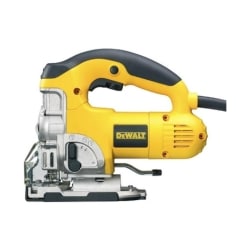
|
Best Corded Jigsaw
|
DeWalt DW331K
|
Features
|
Check Price Now DeWalt DW331K Review DeWalt DW331K Review |
|
Best for Blade Life 
|
Best for Blade Life
|
RYOBI One Plus Jigsaw P5231
|
Features
|
Check Price Now RYOBI One Plus Jigsaw P5231 Review RYOBI One Plus Jigsaw P5231 Review |
Corded and Cordless Jigsaw Buying Guide
Offering precision and accuracy for nonlinear cuts — corded and cordless jigsaw machines are as crucial for DIYers as they are for tradies.
Jigsaws were invented in 1947 when Albert Kaufmann, a Swiss engineer, derived the design from his wife’s sewing machine. He replaced the machine’s needle with a saw blade and found it to be highly effective.
Compact, lightweight, corded and uncorded modern jigsaws feature a reciprocating blade, and are primarily designed for curved cuts in materials, such as wood, metal and plastic. They can also make straight cuts — both along (rip cuts) and across (cross-cuts) the grain of the wood, as well as at an angle (bevel cuts). Although, other saws, such as circular saws, are better suited to this task.
Jigsaws are also one of the only saws that can perform plunge cuts — where a cut is commenced in the middle of a soft material (like wood or plasterboard) without any initial hole.
This is done by starting the jigsaw when the blade is horizontal, and slowly easing it down into the material. Naturally, only using blades specifically designed for this type of cut.
When choosing a mains-powered or cordless jigsaw, consider:
- Power.
- Lock-on button.
- Blade clamp.
- Speed.
- Bevel capability.
- Orbital/pendulum action.
Jigsaw Blade Types
The blade that a jigsaw power tool uses is the key characteristic that defines its cutting capabilities.
Always ensure the tool is disconnected from the power source before changing accessories. Here are more safety recommendations.
There are many different types of jigsaw blades available, and each one has its own style and characteristics:
T-Shank
The component that causes the most confusion with jigsaw blades is the blade’s shank — it’s the part of the blade that locks into the tool’s blade clamp.
The most common style of blade shank and the one with the widest range of blades is the ‘T’ shank — also known as a ‘tang.’ This format offers superior retention and allows the use of keyless blade clamping systems — it’s the style most manufacturers are now using for jigsaws.
U-Shank
The older standard was the ‘U’ shank — also known as the quarter-inch universal shank, but these blades are now becoming difficult to purchase. They’re characterised by a ‘U’ shaped cut-out at one end and are normally locked into the blade clamp with a hex drive screw.
MA-Shank
Another older style of blade shank is the ‘MA’ or Makita shank. Used exclusively on older Makita jigsaws, they’re clamped in place through one of the two fixing holes in their shank.
They have now fallen into relative obscurity, making blades hard to source. The type of shank a jigsaw will take depends on the model and manufacturer of the jigsaw. If you’re not sure, it’s a good idea to consult your tool’s manual.
Jigsaw Blade Construction
Blades can be designed for either straight, curved, or plunge cuts. All jigsaw blades are capable of cutting straight lines, but those that have constant parallel edges are designed especially for repetitive straight cutting.
Curved cutting blades can be recognised by how the teeth of the blade are set back from the front of the blade.
Plunge-cutting blades have a special tip on the end that allows them to slowly bite into the middle of a soft material — like wood or plasterboard — without a pilot hole. They aren’t available for harder materials like metals, which require a starting hole.
Jigsaw blades are generally made of either high-carbon steel or high-speed steel — or a combination of both. High carbon steel blades are very flexible, but wear the fastest and are easily damaged from excessive heat.
High-speed steel blades are harder and more resistant to wear, but are less flexible. To achieve the best of both worlds and for more demanding applications, bi-metal blades were designed. They have high carbon steel bodies and high-speed steel teeth, providing both flexibility and durability, and are essentially shatter-proof.
Some jigsaw blades also feature tungsten carbide tipped (TCT) teeth for use on specialised applications. Jigsaw blades also have differing quantities of teeth. This is usually relative to their application, but generally speaking, the more teeth, the finer and slower the cut. The number of teeth on a jigsaw blade is usually measured by a ‘tooth-per-inch’ (TPI) measurement.
Jigsaw Blade Cutting Capacity
Each blade will have recommended thicknesses for specific materials that it’s capable of cutting.
A shorter blade will have a smaller cutting capability than a longer blade — as well as possessing finer teeth. The specific capacity will be stated on the blade’s packaging.
Jigsaw blades can become extremely hot after use, and I recommend you wear gloves when removing them.
Once the correct blade has been selected and fitted, it’s important to remember to let the blade do the work. Forcing the saw along will only result in substandard results and shorter blade and tool life. If the work rate decreases, it is most likely the blade is blunt and needs to be changed.
Jigsaw Operating Tips
The following tips will help to preserve the life of your jigsaw, increase your efficiency, and most importantly, keep you safe:
- When cutting hard materials like metals, use a slow speed.
- Alternatively, when cutting soft materials like wood, use faster speeds.
- Never apply excessive forward pressure to the tool — always let the blade do the work.
- Always ensure blades are sharp to ensure less load on the tool and better cutting results.
- Cutting oil is recommended for metal cutting applications — except brass and iron.
- Always let the blade cool naturally — never force it to cool down in water or other liquid.
- Operate the saw with two hands, standing with legs apart for stability.
- Let the blade run freely for a few seconds before commencing the cut.
- Personal protective equipment (PPE) must always be worn when operating power tools.
How To Choose the Best Cordless Jigsaws and Corded Jigsaws
The best jigsaw depends on both your preferences and project demands. What might be important for the trade professional may be of less significance for the home DIYer.
Here are a few factors to consider when selecting your ideal jigsaw unit:
Corded or Cordless
Initially, consider whether a mains-driven or battery-driven jigsaw is more suitable.
Corded machines typically deliver more brawn than their cordless counterparts. Furthermore, since they don’t need recharging, you can work for extended periods without a break — as long as you have access to a power socket.
Cordless jigsaws offer significant operational freedom, and the lack of a cord allows for increased manoeuvrability. The downside is, that without backup cells, you’re restricted on your working time.
Power
Measured in volts for battery-powered units and watts for corded jigsaws, the power value typically defines a machine’s speed and grunt — more power generally means a faster and stronger machine. However, internal gearing can also have an effect.
If your projects include driving through dense mediums like hardwood, consider a high-powered unit. Conversely, if you’re planning on cutting through softer timbers or plastics, a less brawny unit may be appropriate.
Personally, I’d suggest avoiding any jigsaws with less than 18 volts cordless or 600-watt corded output — as they will be insufficiently grunty for many projects.
Speed
I recommend opting for a jigsaw that offers variable speed settings — allowing you to tailor the output rapidity to suit your target material. Some units include a setting dial, and others are controlled by a variable trigger.
Jigsaw speed is measured in SPM — strokes per minute. Choose a unit that can achieve at least 2400 SPM.
Lock-on Button
If you’re working on lengthy projects, finger fatigue can become an issue. Many jigsaws boast a locking-on function — permitting you to release the trigger yet allowing the machine to continue running.
This is a welcome stamina-boosting feature — ideal for hardcore DIYers and tradies.
Blade Clamp
The blade clamp is the component of the jigsaw that secures the blade in place. On some jigsaws, the blade clamp includes one or two hex drive screws that must be tightened to lock the blade in place.
On more premium jigsaws, the blade clamp is nearly always a keyless system — allowing you to change a blade in seconds, without having to hunt for a hex or Allen key.
Bevel Capability
Some jigsaws are capable of bevel cutting — meaning you can make angled cuts, ideal for projects such as picture framing. This is achieved by adjusting the angle of the jigsaw’s base plate.
Pendulum/Orbital Action Switch
The blade of a jigsaw travels in a rapid up-and-down motion. However, some jigsaws have a switch that engages a slightly different motion, called pendulum action, controlled via a switch.
Also known as orbital movement, it swings the blade forward and backwards slightly as the blade travels up and down. The majority of jigsaws penetrate material on the upward reciprocating stroke — the orbital action pushes the cutting edge tightly against your target medium, boosting its cutting power.
In wood, it can be used to speed up cutting, and in metal, it can be used to clear metal shavings. The drawback is that it creates a rougher finish.
Our Top Picks of the Ultimate Corded and Cordless Jigsaws
Lightweight, with straightforward operation for the DIYer, and promising welcome safety and comfort features — the PST18LI Bosch cordless jigsaw is perhaps the best battery jigsaw currently available. Driven by an 18-volt cell, the tool knocks out a 2400 SPM and can produce a cutting depth of 80 mm in wood and five millimetres in steel.
For risk-free operation, the PST 18LI includes overload protection — while also providing overheating safeguards that defend the internal components and ensure a pleasant user experience. An in-built LED lamp illuminates dark and dim working areas, and this Bosch 18v jigsaw’s orbital blade movement ensures fast and efficient material cutting.
Bosch 18v Cordless Jigsaw PST 18 LI

Pros
Lightweight.
Stainless steel baseplate.
Soft-grip handle.
Ideal for DIYers.
Excellent cordless jigsaw reviews.
Cons
Doesn’t include a battery or charger.
Significant vibration at high speeds.
An affordable price point combined with impressive capabilities makes the BDCJS18N-XE an excellent Black+Decker 18V jigsaw for DIYers on a budget. As a pendulum machine, it delivers rapid cutting — even through metal — while pushing out 2500 SPM from its powerful motor.
Three positive bevel settings — at 0, 22.5 and 45 degrees — permit this BLACK+DECKER cordless jigsaw to effortlessly tackle beveling and jointing projects. A welcome lock-on feature saves digit fatigue by engaging the motor without having to keep the trigger depressed — while variable speed allows you to select the ideal rapidity for your target material.
Black+Decker BDCJS18N-XE

Pros
Tool-free blade change.
Triple pendulum position.
Both T and U shank compatible.
Stroke length of 19mm.
Blade guard.
Cons
Skin only — no charger or cell.
Fiddly blade exchange.
A rapid stroke rate, mighty pendulum action, and impressive non-slip grip make the STAB 18 LTX 100 Metabo cordless jigsaw one of the best 18-volt machines on the market. Delivering 2800 SPM, the tool is ideal for dense woods and sheet metal. And, with an in-built blower function — keeps your cutting line free from dirt and debris.
This Metabo cordless D-handle jigsaw incorporates a generously padded and textured grip — providing welcome stability while staving off fatigue on longer projects. Furthermore, with a lock-on feature and low profile blade guide — and arriving with a plethora of accessories including a wrench and extraction nozzle — it’s an ideal first jigsaw for the DIYer.
Metabo STAB 18 LTX 100

Pros
Variable stroke rate.
Spring supports.
Bevel capability.
Effortless operation.
Ergonomic D-handle design.
Cons
A Metabo 18V cordless jigsaw without a cell or charger.
Liable to kickback.
Knocking out an eye-watering 3500 SPM, the M18FJS0 Milwaukee cordless jigsaw is the ultimate machine for serious DIYers and pros who demand the ultimate in rapidity. Promising low-kickback and minimal material chipping, this Milwaukee jigsaw also features an intense LED lamp — delivering significant illumination to your cutting line.
A substantial side-mounted switch allows you to choose between four cutting angles — zero, 15, 30, and 45 degrees. Underneath the tool, a smooth shoe cover ensures your target material remains unblemished with each pass. And, with the Milwaukee FUEL cordless D-Handle jigsaw boasting an integrated blower, your working area will stay detritus and dust-free.
Milwaukee M18FJS-0 Jigsaw

Pros
Double-finger trigger.
Five-year warranty.
Compact, small cordless jigsaw.
Orbital cutting action.
Includes hex wrench.
Cons
This Milwaukee 18V cordless jigsaw doesn’t include a charger or battery.
Premium price for a premium machine.
With a low price, straightforward operation, and DIY-focused features — the 220040 Katana pendulum jigsaw targets the novice user. Despite being in the budget category, the unit still provides impressive features — including a pendulum cutting action, ergonomic handle, and trigger lock-on function.
The tool knocks out a solid 2500 SPM — suitable for the majority of home DIY projects. Its toolless system permits rapid blade exchange, while three bevel settings make the unit suitable for angled passes. Yet, while this budget unit offers an in-built LED lamp and dust blower — it arrives without a cell or charger.
Katana Cordless Pendulum Jigsaw

Pros
Affordable price.
DIYer focused.
Lightweight at 1.78 kg.
Three bevel settings.
Integrated blower/extractor.
Cons
No battery pack or charger.
Only T-blade compatible.
Unsubstantial base plate.
Boasting a unique 90-degree pivoting head — the WORX 20V jigsaw Powershare effortlessly transforms from a jigsaw into a reciprocating saw! Compatible with both saw blade types — this machine provides 3000 SPM in either tool mode, while incorporating a blower to keep your working area dust-free.
For safety, the unit requires twin-button depression to prevent accidental startup. And, at just 1.5 kg, remains reassuringly lightweight to elevate project stamina. The WORX 20V cordless multi-purpose reciprocating jigsaw features variable speed control, and provides effortless blade exchange with its toolless clamp.
WORX Reciprocating Jigsaw

Pros
Novel two-in-one machine.
Effortless switching from jig to recip at the touch of a button.
Includes four blades.
Pendulum action.
Suitable for metal, wood, plastic, and tiles.
Cons
Brushed, not brushless, motor.
Little handle comfort or grip.
Lacks battery and charger.
With its immense 3500 SPM and high-efficiency motor, the CJ36DA Hikoki cordless jigsaw is the ultimate brawn machine — making it ideal for the toughest of materials and longest of jobs. Its brushless motor energy is lost through heat and friction, ensuring high 36-volt power delivery and long cell life from a single charge.
Four variable speeds — adjusted by a front-mounted dial — permit you to select the perfect rapidity to suit your target material. The Hikoki barrel-handle jigsaw incorporates an LED lamp to illuminate your cutting line, while a handy dust extractor connector keeps your work area free from dust and wood cuttings.
Hikoki CJ36DA Cordless Jigsaw

Pros
Mighty 36 volts of power.
Brushless motor.
Toolless blade exchange.
Right or left-handed operation.
Bevel function.
Cons
Doesn’t include a battery or charger.
Awkward variable speed dial position.
Offering three orbital settings — the DJV180Z Makita battery jigsaw is one of the most impressive pendulum saws. Its 18-volt motor provides a speedy 3000 SPM, while a patented Soft-No-Load system automatically adjusts the output rapidity to perfectly suit your target material — reducing kickback, chipping, and false starts.
Three bevel settings permit you to adjust the cutting angle for bevels and mortises — and toolless blade exchange ensures minimal downtime. This Makita cordless jigsaw incorporates a handy rear-mounted variable speed dial — and, with a handy blade lock-on button, saves digit fatigue on longer jobs.
Makita Cordless D-Handle Jigsaw

Pros
The Makita 18V jigsaw is brushless — long battery life.
Includes 1 x jigsaw blade.
Constant speed control.
Pro-grade manufacturer.
Triple pendulum action.
Cons
Arrives without a cell or charger.
Unbalanced with front-heavy build.
Truly pro-grade, the DW331K DeWalt jigsaw drops the battery power in favour of a mains cord — for the ultimate performance. Its immense 700-watt motor provides a brawny 3100 SPM — while the four-stage pendulum action permits you to select the perfect grunt and aggression for your target material.
Trademarked anti-vibration systems combined with its robust rubber grip help to tame the beast and permit lengthy, fatigue-free operation. Its modular build means that repair and component replacement is effortless — while an included heavy-duty carrying case ensures tool protection and straightforward transportation from site to site.
DeWalt Barrel Grip Jigsaw

Pros
Professional grade.
Mains powered for ultimate grunt.
Keyless blade exchange.
Bevels from 0 to 45 degrees.
Arrives with a carry case.
Cons
Overkill for the weekend DIYer.
Incorporating its unique and trademarked BladeSaver system, the P5231 Ryobi 18v jigsaw elongates blade life — cutting back on time-wasting replacement and saving your hard-earned dollars. Its grunty motor delivers 3000 SPM, while the cutting edge is adjustable through three bevel settings.
Its variable speed dial is located underneath your gripping hand’s thumb — allowing for effortless adjustment while you’re using the tool. A built-in dust blower keeps your working area clean from detritus, and a bright LED lamp allows you to accurately follow your cutting line, whatever the ambient light conditions.
RYOBI One+ P5231

Pros
Novel BladeSaver system.
Solid build.
Base drop feature.
Quad orbital system.
In-built LED lamp.
Cons
Battery and charger not included.
Not the quietest cordless jigsaw.
Jigsaw Conclusion
Providing cutting accuracy in wood, metal, and plastics — both corded and cordless jigsaws are essential tools for trade pros and home DIYers.
When selecting your ideal machine — first consider whether you want the freedom and convenience of a battery-operated unit, or the ultimate grunt and reliability of a corded tool.
Then, think about the slicing rapidity (SPM) demanded by your projects, whether you need the machine to be capable of bevel cutting, and if you need the convenience of dust blowers, extractors, or LED lamps.
Sure, your garage or workshop may already be home to a multitude of different saw types — but no genuine pro or home-improver’s arsenal is complete without a corded or cordless jigsaw.
Corded and Cordless Jigsaws FAQs
How Do I Maintain My Jigsaw?
Always clean your tool after use. Furthermore, ensure that the moving parts are oiled (as recommended by the manufacturer), the cutting edge is sharp and free from detritus, and check the blade is aligned perpendicularly.
Can I Make Curved Cuts With a Jigsaw?
Yes! Jigsaws are the perfect cutting tools for making both straight and curved cuts in metal, plastic, and timber.
Is a Jigsaw a Reciprocating Saw?
Yes and no! A jigsaw can be considered a reciprocating saw, as its blade moves in a reciprocal direction — that is, backwards and forwards. However genuine recip saws cut horizontally, in line with the handle grip. Conversely, jigsaws cut at 90 degrees to the handle.



